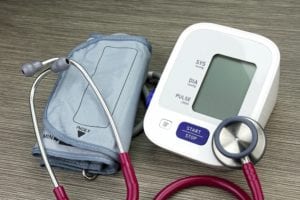Written by Joyce Smith, BS. This study demonstrated that a twelve-week supplementation with a grape seed proanthocyanin extract (GSPE) helped maintain vascular elasticity and normal blood pressure (BP) in a middle-aged Japanese population.
 In 2015, the World Health Organization (WHO) attributed 9.4 million deaths annually to hypertension, reflecting a total mortality of 16.5% and a global presence of hypertension in 22.3% of adults, 18 years of age and older 1,2.
In 2015, the World Health Organization (WHO) attributed 9.4 million deaths annually to hypertension, reflecting a total mortality of 16.5% and a global presence of hypertension in 22.3% of adults, 18 years of age and older 1,2.
Nitric oxide (NO) plays a critical role in controlling blood pressure by vasodilation or relaxation of the endothelial layer of blood vessel architecture to increase blood flow. Thus having an adequate amount of NO production is vital for maintaining normal blood pressure levels and reducing the risk for cardiovascular disease 3,4. Another disrupter of endothelial function is the generation of reactive oxygen species (ROS) (or free oxygen radicals) that reduce the body’s availability of NO 3,5. Several studies in both humans and rodents have linked antioxidant use to improved oxidative stress and vascular health, and reduced cardiovascular risk. Vitamins C and E, genistein, and polyphenols have all been shown to decrease BP by reducing ROS levels, thus improving vascular endothelial function 6,7. A class of polyphenols known as proanthocyanins (of which grapes are a good example) are also powerful antioxidants 8. Odai and team, in a recent study, demonstrated that 8 weeks of (GSPE) successfully reduced BP in Japanese women. Their present study further elaborates on the effects of GSPE on BP and endothelial function and elucidates the mechanisms involved.
In a randomized, placebo-controlled trial 9, 30 prehypertensive patients (6 men, 24 women, aged 40-64 years) were divided equally into three groups of 10 per group: a low-dose group (200mg/day of grape seed extract), a high-dose group (400 mg/day of grape seed extract) and a placebo group to receive 12 weeks of supplementation. Systolic and diastolic blood pressures (SBP and DBP, respectively), brachial flow-mediated dilation (FMD), and other cardiovascular parameters were measured before and after 4, 8, and 12 weeks of treatment. FMD is an index of endothelial function and refers to dilation (widening) of an artery when blood flow increases in that artery, primarily due to the release of nitric oxide by endothelial cells.
Overall, the high dose of grape seed extract demonstrated the greatest blood pressure reduction. Mean SBP significantly decreased from 148 to 135 mmHg (a drop of 13mmhg, P=0.028) in the high dose group and only slightly in the low dose group (144 to 142.5 mmHg) and in the placebo group (150 to 144 mmHg). DBP dropped 96 to 89.9 mmHg (high dose group) compared to 95.9 to 94.3 mmHg (low dose group) and 98.4 to 97.1 mmHg (placebo group). There was no change observed in FMD. The high dose group also experienced improvement in blood vessel health with respect to blood vessel stiffness and distensibility.
In a sub-group analysis of non-smoking participants (n=21), a greater benefit from grape seed extract was observed in the high dose group, where mean SBP decreased by 13.1 mmHg and DBP decreased by 6.5 mmHg. The findings that GSPE improved BP and vascular elasticity without affecting FMD indicate that the antioxidant effects of GSPE regulated vascular tone not through NO release, but by other endothelial responses, which resulted in BP reduction.
Study limitations include small sample size, short study duration, and a Japanese population that limits generalization to other populations, questionable product purity, and no evaluation of plasma proanthocyanin concentration or oxidative stress status.
Source: Odai, Tamami, Masakazu Terauchi, Kiyoko Kato, Asuka Hirose, and Naoyuki Miyasaka. “Effects of Grape Seed Proanthocyanidin Extract on Vascular Endothelial Function in Participants with Prehypertension: A Randomized, Double-Blind, Placebo-Controlled Study.” Nutrients 11, no. 12 (2019): 2844.
© 2019 by the authors. Licensee MDPI, Basel, Switzerland. This article is an open access article distributed under the terms and conditions of the Creative Commons Attribution (CC BY) license (http://creativecommons.org/licenses/by/4.0/).
Click here to read the full text study.
Posted May 18, 2020.
Joyce Smith, BS, is a degreed laboratory technologist. She received her bachelor of arts with a major in Chemistry and a minor in Biology from the University of Saskatchewan and her internship through the University of Saskatchewan College of Medicine and the Royal University Hospital in Saskatoon, Saskatchewan. She currently resides in Bloomingdale, IL.
References:
- WHO. Hypertension Fact Sheet. 2019; Available at: https://www.who.int/news-room/fact-sheets/detail/hypertension, Accessed May 14, 2020.
- WHO. Q&A’s on Hypertension. 2015; https://www.who.int/news-room/q-a-detail/q-as-on-hypertension. Accessed May 14, 2020.
- Harrison DG. Cellular and molecular mechanisms of endothelial cell dysfunction. J Clin Invest. 1997;100(9):2153-2157.
- Ignarro LJ, Buga GM, Wood KS, Byrns RE, Chaudhuri G. Endothelium-derived relaxing factor produced and released from artery and vein is nitric oxide. Proc Natl Acad Sci U S A. 1987;84(24):9265-9269.
- Touyz RM. Oxidative stress and vascular damage in hypertension. Curr Hypertens Rep. 2000;2(1):98-105.
- Ulker S, McKeown PP, Bayraktutan U. Vitamins reverse endothelial dysfunction through regulation of eNOS and NAD(P)H oxidase activities. Hypertension. 2003;41(3):534-539.
- Si H, Liu D. Genistein, a soy phytoestrogen, upregulates the expression of human endothelial nitric oxide synthase and lowers blood pressure in spontaneously hypertensive rats. J Nutr. 2008;138(2):297-304.
- Ariga T. The antioxidative function, preventive action on disease and utilization of proanthocyanidins. Biofactors. 2004;21(1-4):197-201.
- Odai T, Terauchi M, Kato K, Hirose A, Miyasaka N. Effects of Grape Seed Proanthocyanidin Extract on Vascular Endothelial Function in Participants with Prehypertension: A Randomized, Double-Blind, Placebo-Controlled Study. Nutrients. 2019;11(12).
